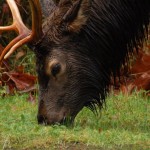WHAT & WHY
The sheer magnitude of marine life on the Olympic Coast is deceptive. At first glance the scene is dominated by ocean, rocks, beach and forest. Each area, however, has secrets to be discovered. Knowing what to look for and when to look are the keys to opening a world filled with pleasant surprises. Seaweeds, invertebrates, whales, seals, sea otters, and birds are visitors to or inhabitants of the Park’s coastal strip. It takes a keen eye and great timing to observe some of these, but others are always present. Either way, each has its own surprising story. Here are a few examples:
- Sea Otters are a member of the weasel family, but unlike their brethren they often live their entire life without ever touching land.
- The gel found in the bulbs of the Rockweed—a type of seaweed—provided the First Peoples with an ointment to soothe sunburned skin.
- Marbled Murrelets are seabirds, but they nest and rear their chicks in old growth forests.
- Fork-tailed Storm Petrels can drink saltwater and are able to sleep peacefully on the waves of a stormy Pacific.
All of the coast’s marine life exists and depends on the cold-water upwelling of the Pacific along the Park’s shore. This upwelling brings with it huge amounts of nutrients, from plankton to fish, and all marine life forms partake of this bounty.
WHEN & WHERE
Regardless of the season, and with the exception of storm conditions, many forms of marine life are observable. The spring passage of Grey Whales occurs from mid-March to mid-April as they return to Alaskan waters from Mexico and feed close to shore. On a calm day they can sometimes be observed from Second Beach near La Push. Sea Otters are present throughout the year and may be observed in areas with large Kelp beds. The floating Kelp coincides with the sea otter’s food sources, and they often wrap themselves in it so that they don’t drift away while napping. All year round, Bald Eagles sit in the branches of tall trees at the edge of the forest, patiently awaiting the arrival of their next meal. Most of the seabirds nest in the rocks and sea stacks off-shore, which provides them with a level of security from all but winged predators. Since the seals and sea lions come ashore almost exclusively on the rocks, off-shore binoculars or a spotting scope are necessary for viewing them.
Marine organisms exist in an unforgiving natural environment, and it becomes the duty of visitors to observe them without contributing to their struggle. Avoid interfering with their natural state and they will survive to be the joyful discovery of those who visit tomorrow.
For more information, visit these websites:



